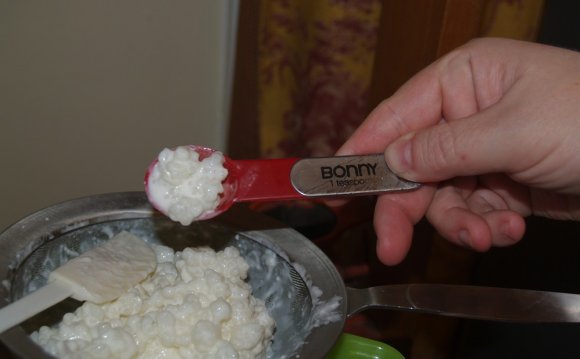
 There is plenty of good information out there explaining the basics of making kefir. However, I found when I started making my own that it wasn’t quite as simple as to put the grains in milk and leave them there for 24 hours. Here is a little FAQ on making kefir that addresses the tougher questions.
There is plenty of good information out there explaining the basics of making kefir. However, I found when I started making my own that it wasn’t quite as simple as to put the grains in milk and leave them there for 24 hours. Here is a little FAQ on making kefir that addresses the tougher questions.
Q. How do I know when the kefir is ‘done’ and ready to strain?
A. I have found that making kefir is more of an art than a science. There is no set time frame for making kefir. Conditions are a factor including room temperature, the vessel being used to ferment the kefir and also the ratio of grains to milk, so you need to experiment a little to figure out what works best for your kefir. Here are some signs to look for after about 18-24 hours of fermenting:
- When you open your fermentation jar you get a loud pop and get splattered with kefir ‘spray’ (tongue in cheek but this happens to me all the time with my Fido jars!)
- The kefir smells nice and yeasty, like beer
- The milk has thickened and looks gelatinous but still fairly thin when stirred
- The milk will have an effervescent taste – like a ‘milk soda’
Q. Help – my kefir separated into liquid at the bottom and a big lump of white stuff on the top? Do I have to throw it out?
A. Of course not! Just shake it up. It might be too sour to drink straight up but it will still be fine to use in smoothies or for making kefir cheese.
Q. Is there a fool-proof way for making sure my kefir doesn’t separate?
A. In most cases, yes. I have found that straining the kefir after 12 hours elapsed time allows me to avoid this issue most of the time. It also makes it much easier to strain and fish out the grains at the 12 hour point because the milk hasn’t thickened yet. I strain off the grains and add new milk to them. I set the strained liquid (what I call ‘the almost kefir’ because it hasn’t thickened yet) in a jar on the counter for a few more hours and then put it in the fridge. Taking the grains out will not cause it to stop fermenting – in fact, it continues but at a bit of a slower rate.
Q. I had a good method going for a couple of weeks and now everything has changed. It is fermenting a lot faster than it was and now I don’t know how long to leave the grains in!
A. The fascinating thing about kefir grains is that they are sustainable. They grow and replicate. Every two weeks or so, my grains double in volume. This then throws off my usual grain:milk ratio and my whole system gets thrown off. Adding the grains and more milk to a larger vessel just compounds the issue for me because it seems that once the grains have more room to grow, they take you up on the offer and replicate even more rapidly to the point of forcing you to kefir a whole gallon of milk in two days. Believe me, I have been there. Here is what I have found to work to keep the madness under some control. Ferment in two vessels of equal size. I normally use one 500ml Fido jar, when my grains start growing, I separate them to two 500ml jars. I do this for 2 or 3 days and when I have healthy sized grains I start giving them away or adding them to smoothies or all of the other creative things you can do with kefir grains. But the key here is that you keep your ratios under control and you don’t end up with fully thickened kefir after 10 hours when you aren’t expecting it.
Q. I am kefiring with non-homogenized milk and now I have kefir cream on top and thickened kefir milk on the bottom. How do I make this consistent? Stirring doesn’t seem to do the job.
A. Strain it with a good thin nylon strainer and it will effectively ‘homogenize’ the kefir for you and break apart those lovely chunks into a smoother drink. Even if I strain at 12 hours (per the answer above), I still strain again before I put IT into the fridge to get a more even consistency.
Q. Can I just pour different batches together in one jar in the fridge?
A. Yes. The milk will continue to ferment even while in the fridge. It is just fine to mix them all together.
Q. What kind of jar should I use?
A. I use the Fido jars but any mason jar will do. However, you don’t want to put a regular top on a Mason jar as the fermentation will create pressure. Just cover a regular mason jar with a coffee filter and a rubber band or a cloth.
Q. I am leaving my house for a few days, how can I put my grains to ‘sleep’?
A. Just add the grains to a fresh batch of milk and put in a sealed jar in the fridge. The cool temperature will allow the grains to feed much more slowly but not indefinitely. The longer you are gone the more milk they will need. I have put my grains to sleep for as long as 10 days in a very large jar with a lot of milk. When you return you simply need to ‘wake’ them back up by adding some fresh milk and possibly going through 1-2 rounds of fermentation. The first batch may not taste to your liking after waking up sleeping grains – you may want to strain after 12 hours and start again with a fresh batch of milk.
YOU MIGHT ALSO LIKE












